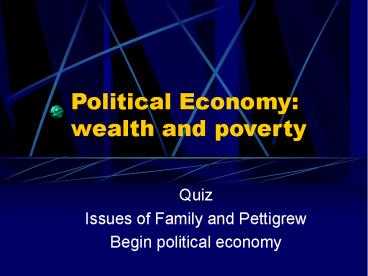Political Economy: wealth and poverty - PowerPoint PPT Presentation
Title:
Political Economy: wealth and poverty
Description:
Political Economy: wealth and poverty Quiz Issues of Family and Pettigrew Begin political economy – PowerPoint PPT presentation
Number of Views:135
Avg rating:3.0/5.0
Title: Political Economy: wealth and poverty
1
Political Economy wealth and poverty
- Quiz
- Issues of Family and Pettigrew
- Begin political economy
2
Discussion of Family
- Is it possible that dysfunctional families will
become the norm in the U.S.? - Is the increasing divorce rate in the United
States leading to an decreased marriage rate? - The strain on the family has been discussed in
class, but is it possible that this is not
strain, but rather, the development of a new kind
of family?
3
Discussion of Family 1
- Is it possible that dysfunctional families will
become the norm in the U.S.? - Following Hochschild, we distinguished 4 types of
families - I suggested that the dysfunctional family was
unintended, transitional and pathological - Many students wanted discussion of that
4
Recall 4 types in Hochschild
Agreed division of labor Disagreement and conflict over DoL
Egalitarian Modern Dysfunctional
Male-dominant Traditional Ambivalent
Are there other types? Is this classification
complete or correct?
5
Dysfunctional
- Hochschilds finding was that one of the
commonest forms of family division of labor was
one in which there was substantial disagreement
and confusion, and a great deal of family
maintenance did not get done by anyone. - I suggested that it was transitional,
pathological and unintentional. This may be
wrong.
6
Discussion of Family 2
- Is the increasing divorce rate in the United
States leading to an decreased marriage rate
I.e. a larger proportion of children not in a
(2-parent) family at all? - Not logically one could have a very high divorce
rate with no decrease in the marriage rate at
all. - And empirically, divorced people remarry.
- But there might be some trends leading to both
7
Discussion of Family 3
- The strain on the family has been discussed in
class, but is it possible that this is not
strain, but rather, the development of a new kind
of family, which does not reflect the family of
classic TV (Leave it to Beaver) - More pluralism?
- Different dominant form
8
Some Pettigrew Questions
- I do not understand the difference between an
invisible hand and an invisible fist. - If there are negative and frustrating outcomes
(of invisible fists and dark clouds then why
do people do them? - Doesnt all unregulated market action lead to
invisible fists?
9
Pettigrews concepts (review)
Outcomes of individual choices Unintended outcomes of public policy
Positive Invisible Hand Silver Lining
Negative Invisible Fist Dark Cloud
10
If they lead to paradoxes and frustration, why do
we do them?
- Individually, we can only change our behavior.
- Sometimes we do not know the outcome.
- Sometimes the outcomes are different for
different people, - Who may have different amounts of power.
11
Doesnt unregulated market action always lead to
invisible fists?
- To some degree even Adam Smith wanted a fair
amount of collective action for education, etc. - But sometimes there are relatively few
consequences for others, or those consequences
are relatively benign. - E.g. family farms.
- Sociologists stress unintended consequences for
others more than economists
12
Many of the overall issues of markets are about
inequality.
The item WLTH POV taps many of the sources of
disagreement about the best scope of
markets Intrinsically, markets often create and
reinforce inequality. For some people, that is
freedom and is OK For others, it is not. In a
free society it is alright if a few people
accumulate a lot of wealth and property while
many others live in poverty.
13
The class response
- About 1/5 agreed about 3/5 disagreed
14
Response in the national sample
- In the whole population, a little less than 1/5
agree, and a little more than 1/5 disagree.
15
How will various background characteristics
affect this item?
- Age
- Income
- Race
- Sex
- Liberalism-conservatism
16
How will agreement with this general attitude
affect the item
- Place yourself on the scale from
- I strongly agree that the government should do
more to improve the living standards of the poor - Agree government should do more
- Agree with both
- Agree people should help self
- Strongly agree that people should help
themselves.
17
Association between support for govt policy and
WLTH POV
WLTH POV by HELP POOR? GOVERNMENT AGR.W
/BOTH PEOPLE Missing TOTAL AGREE 62 140 151 171
353 17.6 39.7 42.8 100.0 NEITHER 32 9
5 51 86 178 18.0 3.4 28.7
100.0 DISAGRE 134 152 71 221 357 37.5 42.
6 19.9 100.0 Missing 272 399 263 517 145
1 TOTAL 228 387 273 995 888
18
Questions for next class
- What is the main cause of the killing in the
Middle East? - What role as U.S. policy played with regard to
it? - What should American policy be?
19
Interesting, useful, non-required colloquium
- 4 Middle Eastern Theorists (one important
sociologist) on the nature of conflict and
dynamic in Israel today - Tollentine 215
- Tomorrow (Friday) 1230
20
Spy Game
- The Robert Redford movie hinges on an incident
where to get rid of a leader of the Palestinian
resistance, the CIA had a client group
organization of Lebanon Christians blow up an
apartment complex with a truck bomb. - We would have preferred to do it a different way
- And Redford was sorry.
- Chomski says it was mosque.
21
Spy Game continued
- Did (does) that happen?
- Is it Typical?
- Does it matter whether it is a matter of explicit
policy?































